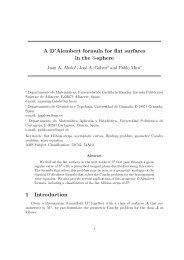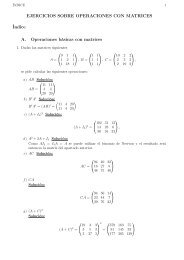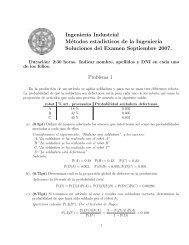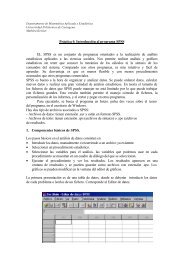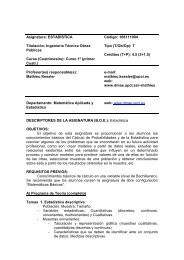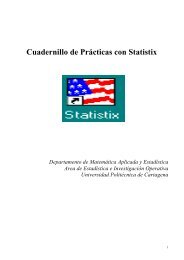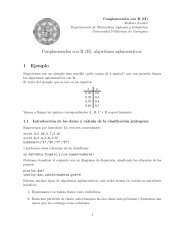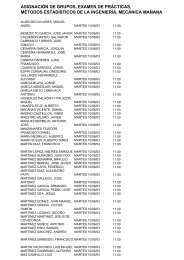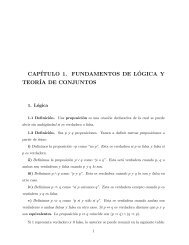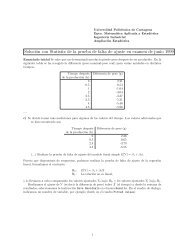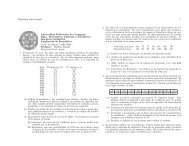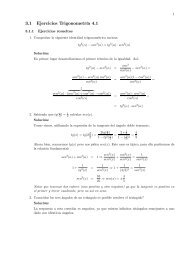Transformada de Laplace y sus aplicaciones a las ecuaciones ...
Transformada de Laplace y sus aplicaciones a las ecuaciones ...
Transformada de Laplace y sus aplicaciones a las ecuaciones ...
You also want an ePaper? Increase the reach of your titles
YUMPU automatically turns print PDFs into web optimized ePapers that Google loves.
<strong>Transformada</strong> <strong>de</strong> <strong>Laplace</strong><br />
Para ver esto proce<strong>de</strong>mos por inducción calculando en primer lugar la <strong>Transformada</strong><br />
<strong>de</strong> f1. Integrando por partes obtenemos<br />
Z +∞<br />
L[f1](z) = e<br />
0<br />
−tz Z x<br />
tdt = lim e<br />
x→+∞<br />
0<br />
−tz =<br />
tdt<br />
µ −xz xe 1 − e−xz<br />
lim +<br />
x→+∞ z z2 <br />
= 1<br />
,<br />
z2 A continuación, por la hipótesis <strong>de</strong> inducción supongamos que L[fn](z) =n!/zn+1 y<br />
calculemos la <strong>Transformada</strong> <strong>de</strong> fn+1. Consi<strong>de</strong>remos<br />
Z +∞<br />
Z x<br />
L[fn+1](z) =<br />
e −tz t n+1 dt. (1.2)<br />
Tomando partes en la expresión anterior<br />
Z x<br />
0<br />
0<br />
e −tz t n+1 dt = xn+1 e −xz<br />
e −tz t n+1 dt = lim<br />
x→+∞<br />
−z<br />
Combinando (1.2) y (1.3) concluimos que<br />
L[fn+1](z) =<br />
+ n +1<br />
z<br />
0<br />
Z x<br />
n +1<br />
z L[fn](z)<br />
(n +1)!<br />
=<br />
zn+2 .<br />
0<br />
e −tz t n dt. (1.3)<br />
• Funciones periódicas. Las funciones periódicas son bastante importantes en ingeniería<br />
<strong>de</strong>bido a que su periodicidad <strong>las</strong> hace controlables. Sea f :[0, +∞) → C una<br />
función periódica con periodo T . Entonces<br />
Z nT<br />
e −tz Xn−1<br />
Z (j+1)T<br />
f(t)dt =<br />
e −tz Xn−1<br />
f(t)dt = e −jzT<br />
Z T<br />
e −tz f(t)dt<br />
0<br />
j=0<br />
jT<br />
realizando cambios <strong>de</strong> variable en <strong>las</strong> integrales y usando que la función es periódica<br />
<strong>de</strong> periodo T . Tomando límites cuando n → +∞, severificapara todo z ∈ C tal que<br />
Re z>0 la relación<br />
1<br />
L[f](z) =<br />
1 − e−zT Z T<br />
e −tz f(t)dt.<br />
1.2.2 Dominio <strong>de</strong> <strong>de</strong>finición <strong>de</strong> la <strong>Transformada</strong> <strong>de</strong> <strong>Laplace</strong><br />
Los ejemplos que anteriormente hemos explicado ponen <strong>de</strong> manifiesto que la función <strong>Transformada</strong><br />
<strong>de</strong> <strong>Laplace</strong> <strong>de</strong> una función f :[0, +∞) → C no tiene porque estar <strong>de</strong>finida en todo<br />
el plano complejo. Vamos a estudiar con precisión cómo es el dominio <strong>de</strong> <strong>de</strong>finición <strong>de</strong> estas<br />
funciones, pero consi<strong>de</strong>raremos una c<strong>las</strong>e especial <strong>de</strong> funciones que tienen lo que llamaremos<br />
or<strong>de</strong>n exponencial.<br />
8<br />
0<br />
j=0<br />
0



